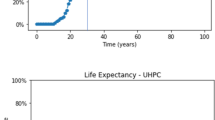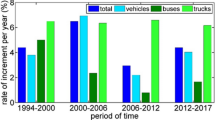Abstract
This study was intended to evaluate the dynamic performance high-speed railway bridges (HSR bridges) of composite box girder type so as to propose the rational safety level and optimal design method using reliability assessment (RA) and expected life-cycle cost (LCC) concpet. To that end, a various design alternatives were created considering the variation of member section based on a standard design section (current Korean code) of HSR bridges and then the static analysis, natural frequency analysis and time history analysis using time series of traffic load were implemented on each design alternative. Based on finite element analysis (FEA) results, the dynamic amplification factor (DAF) of the standard design section was evaluated in a way of comparing with related alternatives. RA depending on design strength limit state function was carried out considering the effect of external uncertainty contained in FEA results by each design alternative. Furthermore, the expected LCC of HSR bridges was evaluated using RA results and the optimal design method was determined through the calculated minimum LCC. To review the effect of internal uncertainty included in the safety index, failure probability and minimum LCC of selected optimal design method, sensitivity assessment was implemented and, consequently, a frequency-histogram (cumulative-percentage) was illustrated. The outcomes of research, along with the dynamic performance assessment of HSR bridges, will be expected to provide the basic information in determining the structural safety and optimal design method.
Similar content being viewed by others
References
Ang, A. H-S. (2006) Practical Assessments of Risk and its Uncertainty, Proc. IFIP Workshop, Kobe, Japan.
Ang, A. H-S. and Tang, W. H. (2007). Probability Concepts in Engineering, 2nd Ed, Wiley, New York.
Cheng, Y. S., Au, F. T. K. and Cheng, Y. K. (2001). “Vibration of Railway Bridges under a Moving Train by Using Bridge-Track-Vehicle Element.” Engineering Structures, 23(12), pp. 1597–1606.
Cho, C. Y., Sun, J. W., Kim, L. H. and Cho, H. N. (2007). “Development of Uncertainty-Based Life-Cycle Cost System for Railroad Bridges.” The Korean Society for Railway Conference, pp. 1152–1158.
Cho, H. N., Min, D. H. and Cho, J. S. (2001). “Optimum Life Cycle Design of High-Speed Railway Steel Bridge.” Journal of Korean Society Civil Engineers KSCE, 21(5-A), pp. 735–760.
Chopra A. K. (1995). Dynamics of Structure: Theory and Applications to Earthquake Engineering, Prentice-Hall, Inc.
De Brito, J. and Branco, F. A. (1995). “Bridge Management Policy using Cost Analysis.” Proc. Instn Civ. Engrs Structs & Bldgs, 104, Nov., pp. 431–439.
Ditlevsen, O. (1979). “Narrow Reliability Bounds for Structural System.” Journal of Structural Mechanics, 7(4), pp. 453–472.
Esveld, C. (2001). Modern Railway Track, 2nd ed., MRTproductions, Zaltbommel.
Ewins, D. J. (2000). Modal testing-theory, practice and application, 2nd Ed., Research studies press LTD.
Frangopol, D. M. and Lin, K. Y. (1997). “Life-Cycle Cost Design of Deteriorating Structures.” Journal of Structure Engineeing ASCE, 123(10), pp. 1390–1401.
Fryba, L. (1996). Dynamic of railway bridges, Thomas Telford.
Han, S. H. (2011). “A Study on Safety Assessment of Cable-Stayed Bridges Based on Stochastic Finite Element Analysis and Reliability Analysis.” KSCE Journal of Civil Engineering, 15(2), pp. 205–315.
Han, S. H. and Ang, A. H-S. (2008). Optimal Design of Cable-Stayed Bridges Based on Minimum Life-Cycle Cost, IABMAS08 Conference, Seoul, Korea.
Han, S. H., Cho, H. N., Cho, T. J., Shin, S. W. and Kim, T. S. (2010). “Risk Assessments of Long-Span Bridges Considering Life-Cycle Cost Concept and Near-Fault Ground Motion Effect.” International Journal of Steel Structures IJOSS, 10(1), pp. 51–63.
Han, S. H. and Park, J. K. (2009). “Practical Valuations on the Effect of Two Type Uncertainties for Optimal Design of Cable-Stayed Bridges.” International Journal of Steel Structures IJOSS, 9(2), pp. 143–152.
Hart, G. C. (1982). Uncertainty Analysis, Loads, and Safety in Structural Engineering, Prentice-Hall.
Hasofer, A. M. and Lind, N. C. (1974). “Exact and.Invariant Second Moment Code Format.” Journal of the Engineering Mechanics Division ASCE, 100(EM1), pp. 111–121.
Kang, K. D. (2006). “Verification of bridges Design criteria for Continuous PSC Box Bridge of High Speed Railway Using Field Test.” Journal of Korean Society of Steel Construction, 18(1), pp. 53–58.
Korea Railroad Research Institute. (2006). Development of stabilization techniques for track construction system of the high-speed railway.
Korea Railroad Research Institute. (2000). Report on development of structure monitoring and assessment system for securing structural capacity of high-speed railway structure.
Koskito, O. J. and Ellingwood, B. R. (1997). “Reliability-Based Optimization of Plant Precast Concrete Structures.” Journal of Structure Engineering ASCE, 123(3), pp.211–219.
Korean Society Civil Engineers. (2004). Railway Design Specification (Chapter of Railway Bridges).
Lee, W. S., Bang, M. S., Han, S. H. and Lee, C. O. (2010). “Reliability-Optimal Design Method of High-Speed Railway Bridges Based upon Expected Life-Cycle Cost.” Journal of the KSMI, 14(4), pp. 102–109.
Ministry of Construction & Transportation. (2000). Development of Structural and Maintenance System for High Speed Railway Bridges and Tunnels Report, 99-II-1-1-5.
Nowak, A. S. and Collins, K. R. (2000). Reliability of Structures, Vol. 268, McGraw-Hill, New York.
Rackwitz, R. and Fiesseler B. (1978). “Structural Reliability Under Combined Random Load Sequences.” Computers and Structures, 9(5), pp. 489–494.
Saiidi, M., Douglas, B., and Feng, S. (1994) “Prestress Force Effect on Vibration Frequency of Concrete Bridge.” Journal of Structural Engineering ASCE, 120(7), pp. 2233–2241.
Song, C. H. (2008). Optimal Dynamic Amplification Factor Analysis of High-Speed Railway Bridges, M.D. Dissertation, Chungnam National University.
Tabsh, S. W. and Nowak, A. S. (1991). “Reliability of Highway Girder Bridges.” Journal of Structural Engineering ASCE, 117(8), pp. 2373–2388.
Wang, T. L., Garg, V. K. and Chu, K. H. (1991). “Railway Bridge/Vehicle Interaction Studies with New Vehicle Model.” Journal of Structural Engineering ASCE, 117(7), pp. 2099–2166.
Yang, Y. B., Yau, J. D. and Hsu, L. C. (1997). “Vibration of Simple Beams Due to Trains Moving at High Speeds.” Engineering Structures, 19(11), pp. 936–944.
Author information
Authors and Affiliations
Corresponding author
Rights and permissions
About this article
Cite this article
Han, SH. Optimal safety valuation of high-speed railway bridges based on reliability assessment and life-cycle cost concept. Int J Steel Struct 17, 339–349 (2017). https://doi.org/10.1007/s13296-014-0165-7
Received:
Accepted:
Published:
Issue Date:
DOI: https://doi.org/10.1007/s13296-014-0165-7




